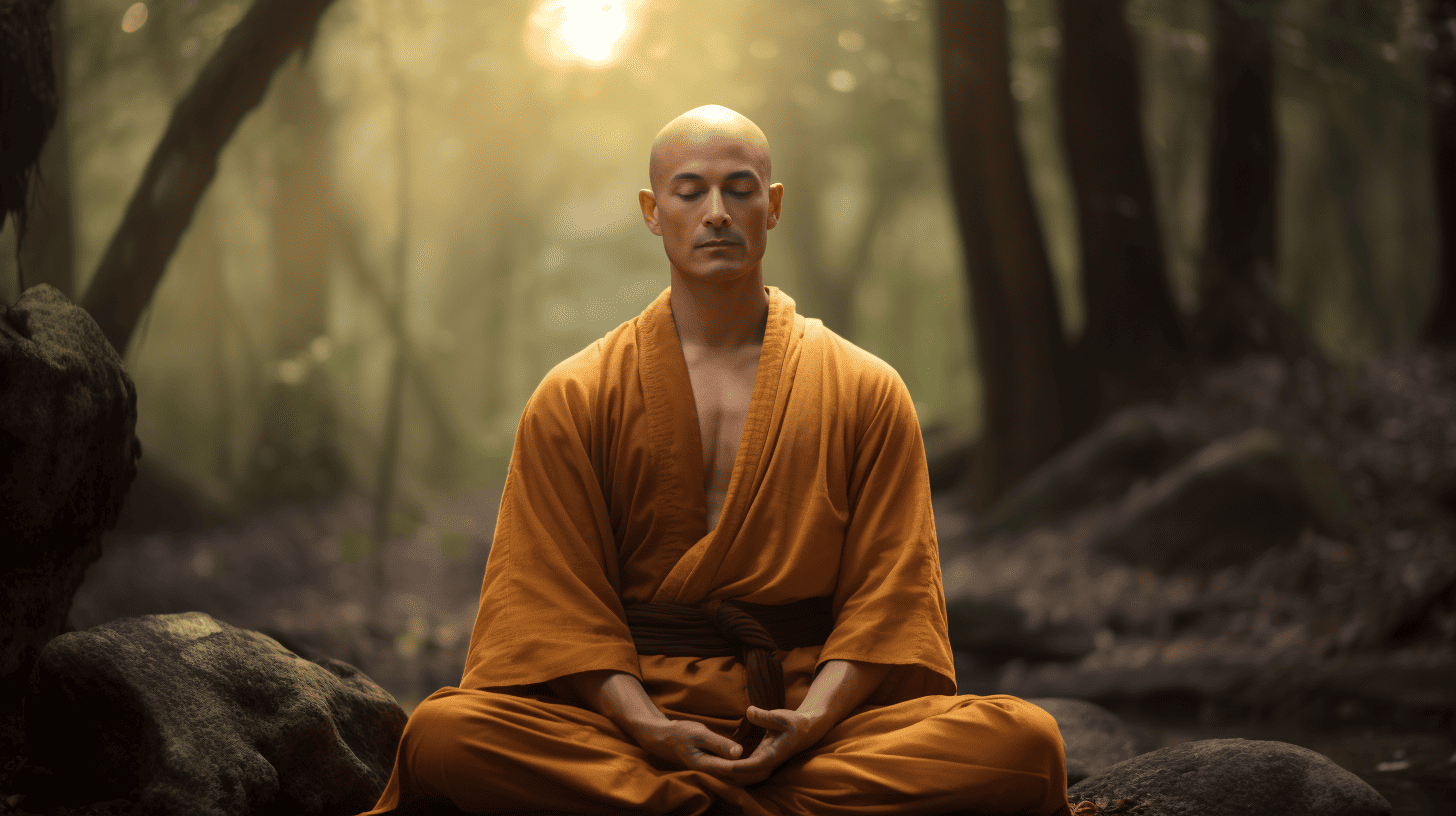Meditation has been an essential part of Buddhism for thousands of years. The Buddha himself achieved enlightenment through meditation, and many Buddhists since have followed in his footsteps to find inner peace and wisdom.
In this guide, I’ll share seven powerful yet straightforward Buddhist Meditation for inner peace to help you cultivate inner peace, calm, and serenity. These practices have been honed over centuries and can be transformative if practiced diligently.
I’ll also share how each works, tips to get the most out of it, and what benefits you can expect over time. Let’s get started!
Key Takeaways:
- Mindfulness of Breathing settles the chatterbox mind, reduces stress and cultivates concentration + clarity
- Loving-Kindness Meditation softens the heart, promotes self/other peace and boosts compassion
- Body Scan unwinds physical/mental tension for deeper embodiment and inner quiet
- Noting practice calms emotional storms, transforming anxious reactions into moments of spacious stillness and insight
- Mantra Meditation uses resonant syllables to anchor awareness beyond thinking into presence
- Walking Meditation instills mindfulness and serenity even amidst movement
- Visualization employs imagination to invoke deeper resources like harmony, joy and healing
- A comprehensive Meditation Course provides full-spectrum training and personal mentoring for awakening liberation, unconditional love and lasting inner peace
Study Buddhism: Start with simple breath-focused meditation, which helps in calming down when stressed. Breathe normally and focus on your breath at either the nose or the abdomen, depending on your state of mind.
1. Mindfulness of Breathing
Mindfulness of breathing is one of the most common introductory Buddhist meditation techniques. It’s simple yet profoundly calming and insightful.
The practice involves focusing your attention intently on the physical sensation of breathing. As you pay close attention to each inhale and exhale, this anchors you in the present moment.
- As your mind starts to wander (which it inevitably will), gently return your attention back to the breath without judgment.
- Simply observe the feeling at the nostrils, chest or belly as the air flows in and out.
By continually returning to this sensation, you cultivate greater concentration, calm and clarity. Over time, mindfulness of breathing leads to a deep serenity and connection with the present.
I like to practice this for 10-15 minutes daily. But even 5 minutes can make a big difference.
To get started, find a quiet space, adopt a comfortable seated posture with your back straight and close your eyes. Bring full attention to your breath, focusing intently on each inhalation and exhalation. When your mind wanders, return to the breath.
That’s all there is to it! With regular practice, the chattering mind starts to settle into stillness and serenity.
“When mindfulness of breathing is developed and cultivated it is of great fruit and benefit” – Buddha
Benefits of Mindfulness of Breathing:
- Induces deep relaxation and inner peace
- Develops stronger focus and awareness
- Reduces stress and anxiety
- Promotes overall wellbeing and happiness
So if you’re looking to find some serenity amidst the noise of modern life, mindfulness of breathing is a simple yet powerful practice.
Check out this free guided meditation on mindfulness of breathing by Gil Fronsdal to get a taste.
2. Loving-Kindness Meditation
Loving-kindness meditation, also known as Metta meditation, is a popular Buddhist practice focused on cultivating unconditional kindness towards oneself and others. This includes friends and family, neutral people in your life, difficult people, and ultimately all beings.
In our complex, often challenging world, Metta meditation helps soften the heart, dissipate anger/fear and promote goodwill, forgiveness and inner peace.
The traditional practice involves silent repetition of specific phrases wishing happiness, health and peace for various people and groups. As you repeat these benevolent intentions, you consciously summon a feeling of compassion, warmth and care.
For instance, common phrases are:
- “May you be happy”
- “May you be healthy”
- “May you live with ease”
You can practice Metta meditation while sitting, walking or even as a part of your daily routine. I find 10-15 minutes once or twice a day impactful.
To begin, find a quiet spot and get comfortable. Close your eyes and start repeating the Metta phrases first for yourself. Really feel the intention and warmth behind the words. Then gradually broaden out the practice for loved ones, neutral people, challenging people and the world.
Stay patient with yourself and don’t force any feelings. With regular practice, Metta meditation organically blossoms into greater kindness, connection and serenity.
“This is what should be done by one skilled in goodness, by one who knows the path of peace.” – Buddha on Metta meditation
Benefits of Loving-Kindness Meditation
- Boosts compassion and feelings of warmth
- Dissipates anger, fear and ill-will
- Deepens connections with others
- Promotes inner peace and harmony
Here is an excellent 20 minute guided Metta meditation by Jack Kornfield if you’d like to give it a try.
Now let’s look at a powerful mindfulness-based technique.
3. Body Scan Meditation
Body scan meditation is another popular mindfulness practice originating from Buddhist meditative traditions.
As the name suggests, a body scan involves systematically sweeping your attention through different parts of the body from head to toe, observing with openness and curiosity.
By carefully tuning into physical sensations in each body region–whether pleasant, unpleasant or neutral–you become deeply rooted in the present. This builds mindfulness, relaxes muscle tension and leads to greater embodiment and inner peace.
I like to set aside 15-30 minutes to practice a full body scan. But even 5-10 minutes focusing on key areas can impart calm.
Find a quiet space where you can lie down comfortably without distraction. Close your eyes, take a few full deep breaths and bring attention to your head and face. Notice any sensations without judging or trying to change them. Hold the area gently in awareness for a few breath cycles.
Then shift focus to the neck and throat area, followed by the shoulders, arms, chest and torso, being present with any sensations arising in each part. Continue down through the legs, feet and toes.
Whenever your mind gets lost in thought, simply return attention back to the body without frustration.
Over time, body scan meditation brings you into closer connection with inner sensations, unwinding physical and mental tension–leaving you centered and at peace.
“There is peace in your body, peace in your mind.” – Thich Nhat Hanh on body scans
Benefits of Body Scan Meditation
- Releases muscle tension and physical stress
- Settles restless thoughts and worried mind
- Builds embodied mindfulness and focus
- Promotes deep relaxation and serenity
Watch this 14 minute guided body scan meditation if you’d like a sample.
The next technique works wonders when difficult emotions or thoughts arise…
4. Noting Meditation for Inner Peace

Noting meditation stems from the Vipassana or “Insight” tradition designed to cultivate deeper wisdom.
The practice involves silently labeling thoughts, emotions and sensations exactly as they arise in each moment. For example, you would softly note “planning”, “anger” or “tension” without trying to suppress anything.
This helps calm the chatterbox mind. By objectively labeling experience without reacting, you gain clarity, equanimity and inner quiet.
Noting meditation is wonderful for transforming difficult states like anxiety, frustration or sadness into moments of insight and peace.
I recommend practicing for 10-20 minutes once or twice daily. But anytime challenging emotions arise, a few minutes of noting can center you.
Start by sitting quietly and observing the constant parade of thoughts, feelings and sensations without engaging them. As they appear, neutrally assign them a simple label like “thinking”, “tension”, “anger”, “planning” etc.
By continuing to note experience as it unfolds without judging, you’ll organically settle into the eye of the storm–a place of deep tranquility and wisdom.
“Only by observing mental states as they arise can one enter the path to liberation.” – Henepola Gunaratana on noting practice
Benefits of Noting Meditation
- Calms emotional storms and anxious thinking
- Builds mindfulness and inner peace
- Transforms reactions into insight
- Weakens destructive thought patterns over time
Here is an excellent 15 minute Noting meditation by Sam Harris exploring common experiences like thinking, boredom and frustration.
The next technique leverages sound to calm and center the mind.
5. Mantra Meditation
Mantra meditation uses repeated words or short phrases to penetrate beyond the chattering mind into serene presence. These mantras create soothing vibrations that harmonize mind and body.
Common Buddhist mantras invoking peace include:
- “Om Mani Padme Hum”
- “Om Shanti Shanti Shanti”
But you can use any phrase resonating personally like “Peace” or “Tranquility”.
To practice mantra meditation, find a quiet comfortable seat, close your eyes and start repeating your chosen mantra aloud or silently. Say each word fully and intentionally.
When thoughts arise, gently return to vocalizing the mantra without self-judgment. To deepen concentration, focus on the sound and sensation of each syllable.
The Enthusiastic Buddhist: Engage in Samatha or Calm Abiding Meditation, where you focus on your breath and count your breaths to increase concentration and reduce distractibility.
Starting with 5-10 minutes daily, you can build up to 20 minutes for a profoundly centering effect. The cyclical mantra anchors awareness in the present, leaving you bathed in serene vibration.
“The essence of mantra meditation is the repeated invocation of certain syllables which calms the chattering mind.” – Lama Yeshe on mantras
Benefits of Mantra Meditation
- Effortlessly blocks distracting thoughts
- Creates deeply relaxing sonic vibrations
- Focuses and settles the restless mind
- Induces sense of peace and tranquility
Here is a lovely 11 minute meditation with the mantra “Om” by The Honest Guys.
The final technique for now utilizes walking to build mindfulness.
6. Walking Meditation
Walking meditation–or kinhin in Zen Buddhism–involves mindfully strolling at a slow steady pace with complete presence. This simple practice cultivates serenity in motion.
Choose a quiet straight path around 10-15 paces in length. Stand still momentarily with eyes closed and attention tuned inward. Feel the rise and fall of each breath.
When ready, begin strolling at about half your normal speed, with awareness anchored in the soles of your feet–noticing every sensation as they touch ground. Tune into sounds, scenery and smells arising too.
If walking faster or getting lost in thought, gently return focus to the feet with non-judgment. Just observe and feel each step with childlike curiosity.
Aim for 10-20 minutes of attentive walking and stillness. You can also practice indoors bywalking circuits around rooms mindfully.
In our busy rushing world, walking meditation brings us back to our senses, unwinding anxiety–leaving us centered and at peace even amidst movement.
“With each step, peace and joy follow.” – Thich Nhat Hanh on mindful walking
Benefits of Walking Meditation
- Settles busyness of the mind
- Relaxes and de-stresses
- Builds embodied mindfulness
- Instills serenity through movement
Here is an excellent 20 minute guided walking meditation by lead Insight Meditation teacher Joseph Goldstein for a sample session.
7. Visualization Meditation
Visualization is a powerful meditation technique utilizing focused imagery to invoke states like inner peace, confidence or healing. Studies confirm engaging the brain’s visual cortex modulates both psychological and physiological processes.
The practice typically starts by visualizing a peaceful setting like a beach, meadow or forest glade. Imagine the details vividly—sights, sounds, scents and textures. Allow feelings evoked to permeate mind and body as you continue visualizing.
You can set an intention like serenity too. As scattered thoughts arise, gently return attention to the visualization without judgment.
Aim for 10-15 minutes daily of immersed imagery. But brief visualization also helps reset emotional states throughout the day.
Here’s a 5 step practice:
- Find a quiet spot, close eyes and relax the body
- Visualize a beautiful, peaceful natural scene. Engage all the senses.
- Feel the serenity, joy and tranquility of this inner world permeating you.
- Set your intention, affirmation or state you wish to cultivate
- Whenever distracted, return attention to the visualization
Creative visualization shifts energy into higher frequencies—leaving you centered, renewed and at peace.
“Visualization practice has the capacity to shift understanding which contributes to emotional and physical healing.” – Linda Graham, Meditation Teacher
Benefits of Visualization
- Accesses deeper states rapidly
- Creates joy, harmony and inner peace
- Reprograms limiting beliefs/emotions
- Promotes self healing and wellbeing
Here is a lovely 15 minute beach visualization for relaxation by Michael Sealey.
The final technique integrates many practices for full-spectrum serenity.
Conclusion on Buddhist Meditation for Inner Peace
By patiently infusing these methods into your days, you progressively unwind destructive patterns, moving from restlessness and turbulence into an unshakable inner sanctuary beyond conditions–available in every step and every breath.
May the practices shared awaken your natural home of entire peace. OM Shanti, Shanti, Shanti.
FAQ on Buddhist Mindfulness Meditation Practice
Q: How can yoga contribute to the process of Buddhist meditation for inner peace?
A: Yoga can play a significant role in Buddhist meditation. It aids in calming the mind, improving concentration, and nurturing the qualities needed for meditative practices. The breathing techniques used in yoga can also help cultivate calmness and serenity, critical elements in achieving inner peace.
Q: How does one’s breath play a role in Buddhist meditation?
A: The breath is a central element in many forms of meditation, including Buddhist meditation. Practices like Anapanasati, or mindfulness of breath, use the breath as a focal point to practice observing one’s thoughts and feelings without judgment, aiding in the cultivation of inner peace.
Q: Can an online course help me learn how to meditate for inner peace?
A: Yes, an online course guided by an experienced instructor can be a helpful resource, especially for beginners. The teachings in these courses can provide guided practices, information about popular forms of Buddhist meditation, and methods on how to handle thoughts and feelings during meditation.
Q: How does cultivating the ability to meditate contribute to inner peace?
A: Meditation helps to cultivate inner peace by promoting mindfulness, contentment, and freedom from suffering. By learning to meditate, an individual gains the ability to observe their thoughts and feelings without excessive judgment. This habit helps in reducing stress and enhancing overall well-being.
Q: Are there apps to assist with Buddhist meditation for inner peace?
A: Absolutely, there are various apps available that offer guided Buddhist meditations and yoga classes. Some apps also provide timers for meditation sessions and teachings on how to develop concentration and mindfulness. These can serve as useful tools for those desiring to cultivate inner peace.
Q: How does one’s level of desire influence their ability to cultivate inner peace?
A: Desire, when excessive and unchecked, can hinder one’s journey towards inner peace as it often leads to discontent and suffering. However, a balanced desire, such as the wish for personal growth or greater peace, can be a motivating force in the practice of meditation.
Q: What is the role of the instructor in teaching Buddhist meditation?
A: An instructor’s role in teaching Buddhist meditation is vital. They provide guidance on the techniques and help develop the right meditation habits. Instructors can also offer advice on how to deal with specific challenges faced during meditation and can adjust the practices to suit the individual needs of students.
Q: How can the practice of mindfulness lead to an awakening?
A: Practicing mindfulness, a form of Buddhist meditation, involves becoming fully aware and present in each moment. It fosters a state of awakening where one experiences a clear, unfiltered perception of reality, with acceptance and without exaggerated reactions. This conscious awareness is said to be a significant step towards achieving inner peace.
Q: Do I need to sit in a certain stage or position, like the chin mudra, to meditate?
A: Comfort is crucial during meditation. It’s often suggested to sit in a comfortable, stable position to meditate. The chin mudra, where the thumb and index finger form a circle while resting on your knee, is simply one of many positions used to enhance focus and energy flow, but it’s not essential. It’s necessary to find a posture that works best for you.
Q: How long should I meditate to develop a regular habit?
A: The frequency and duration can vary by individual preference. Scholars suggest starting with short durations, like 5 to 10 minutes every day, and gradually increasing it as you get comfortable. Ultimately, consistency matters over the length of each session to create a sustainable meditation habit.





Leave a Reply